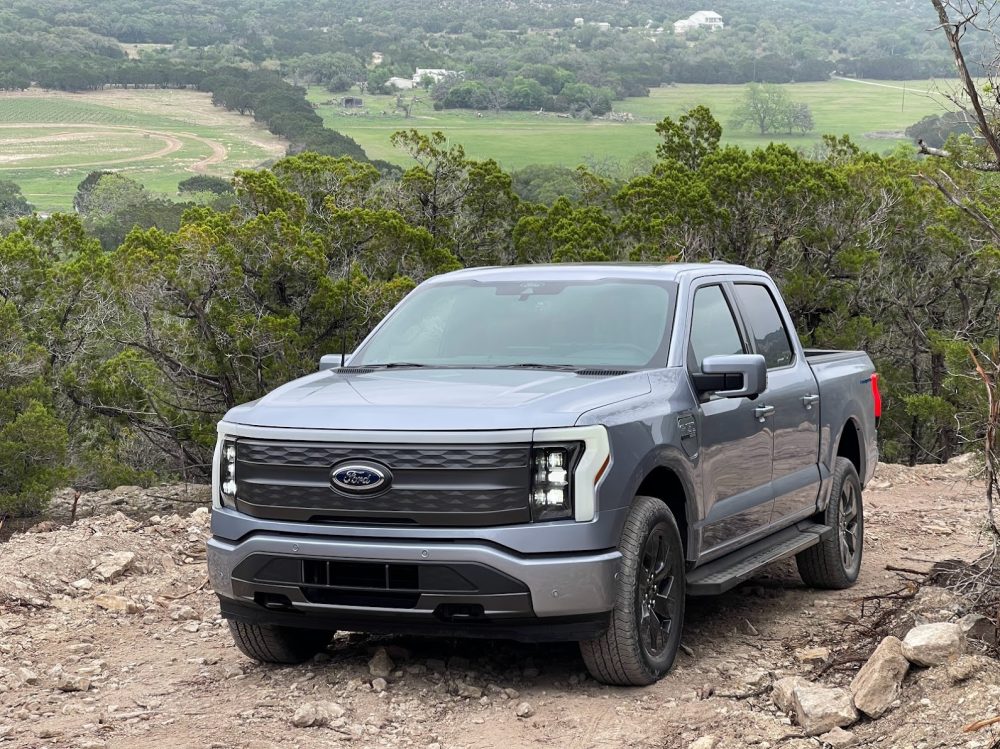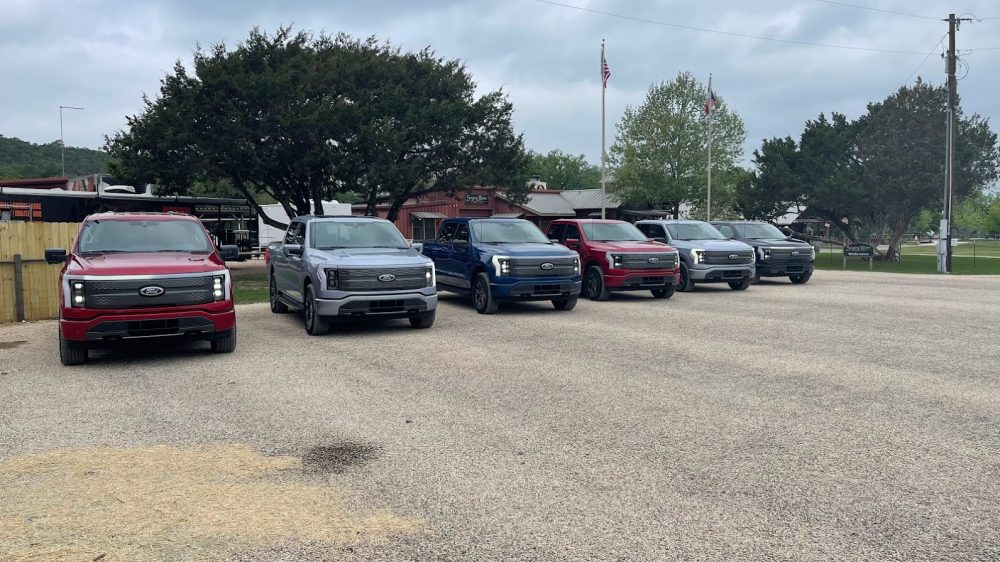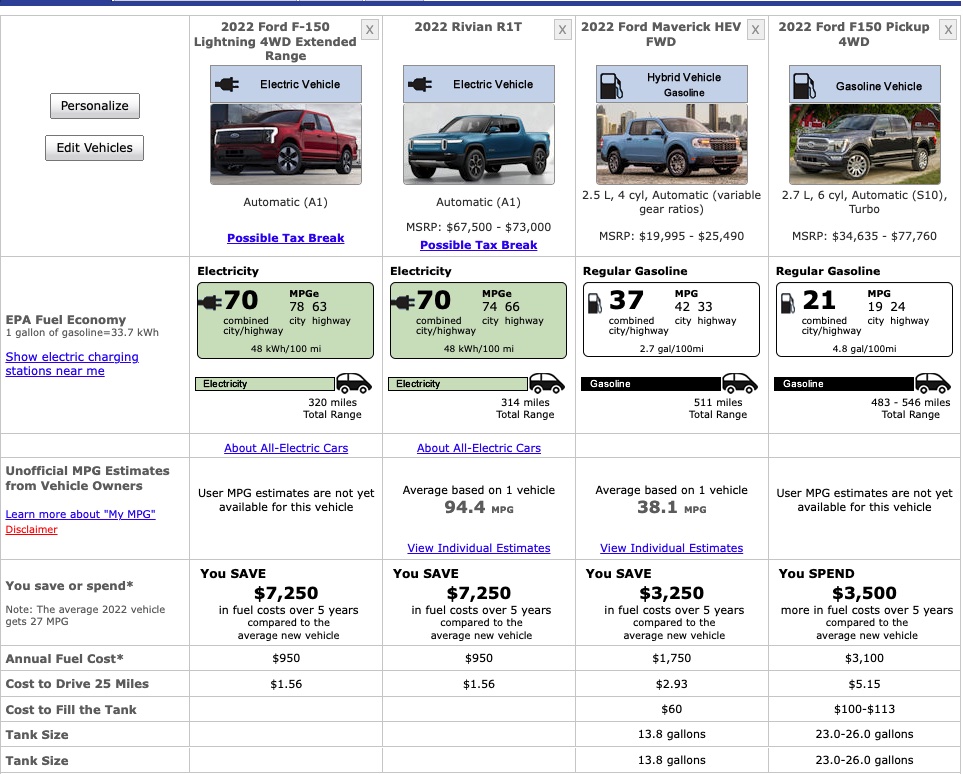
[ad_1]
Ford flew us down to San Antonio, Texas, and took us around town and out to a lovely country winery to test the Ford F-150 Lightning in its natural habitat. They say everything’s bigger in Texas…
Ford calls the F-150 Lightning the smartest, most innovative F-150 that Ford has ever built. It is easy to see why. Compared to a normal F-150, the Lightning has:
- 10-kilowatt smart power plant on wheels, for three-plus days of whole house backup, powering a job site, or one day offsetting super peaks in a V2G application
- 0-60 acceleration in the mid to low four-second range, beating even the Raptor by almost a second
- Quiet, low vibration drive yet with 580 HP 775 lb.-ft. of torque – the most torque of any F-150 ever
- Low center of gravity for better handling in weather
- Ability to charge another electric vehicle
- Mega Power Frunk, which has 400 liters of volume and 400 pounds of payload. Lockable and with internal plugs to keep tools charged
- Just shy of the ICE max: 2,235-pound payload and up to 10,000-pound towing capacity but the Lightning tows in a way that you almost immediately and completely forget you are towing
The one area the Lightning falls short of the gasoline F-150 is range with a 230-mile base and 300- to 320-mile extended range setup. The Lightning is also a much heavier vehicle because of the batteries at 6,500 pounds, which is 35% more than a gas-powered F-150. Why? That 1,800-pound battery has a lot to do with it.

Approaching the F-150 Lightning
My flight was delayed so I missed the introductory meeting and got off late on our trip around San Antonio. That means I caught a little more traffic than the other group, which included our video producer Miles, who I planned on joining for the whole trip.
Getting in the F-150 is a huge literal step up. All the models we drove included a running board (the base Pro models don’t), which was certainly appreciated by my 48-year-old knees. Climbing into the driver’s seat, you notice the vast, wide cabin. The area that is an armrest in a normal vehicle can open to make a workspace as the shifter folds down. It is the size of a small desk between the driver’s seat and the passenger. This would make a great mobile office, especially with all of the USB-C and 20A (!!) 110V plugs available on the dashboard.
Which is to say the F-150 is wide inside. Anecdotally, where in most vehicles I can reach the passenger door from the driver’s seat, my bag fell off the “desk” into the passenger footwell area. In most vehicles, I’d be able to reach it, but in the F-150 I had to stop, unbuckle, and get out of my seat to get my bag.
All of that is to say that this is a huge vehicle and it feels like one on the road. You are elevated quite a bit, and at that height and with the massive width of this thing, it feels like you are going to hit the curb or oncoming traffic, even if you are only a few inches closer.
Ford F-150 Lightning Ride
You turn on the F-150 Lightning like many vehicles, with a power button – then you simply shift into “Drive.” That’s where the similarities to traditional F-150s end. With barely a whisper, the F-150 lunges forward and you are on your way with the agility of a sports car. This huge 6,500-lb. vehicle now feels as agile as a sedan with a low center of gravity. On the highway and want to pass a car going 60 mph? The 60-80 mph acceleration is almost as impressive as its four-second 0-60.
The frame is still a hulk, and things like navigating a tight construction zone or *gasp* parking are still tumultuous. But once you are out on the open road, the Lightning feels amazing.

Ford F-150 BlueCruise doesn’t require hand holding
Unlike self-driving from Tesla and Rivian (or even Ford’s own Mustang Mach-E), Ford’s F-150 BlueCruise doesn’t require you to hold the wheel while the car is “driving itself.” That’s because to the right of the steering wheel on the dashboard is an eye-tracking sensor that makes sure your eyes stay on the road.
In our drive, we went almost 25 miles and almost a half hour on a busy highway during rush hour without an intervention. Only when the lines on the road were discombobulated by a construction zone were we forced to intervene.
The BlueCruise sensor doesn’t put up with any messing around. Looking out the side window or your lap for an iPhone for more than a second or two and you get loud audible warnings. Even looking at the instrument cluster for too long invokes the loud beeping and dash warnings.
It also doesn’t do fancy things like navigate or even change lanes. It is a simple but extremely effective traffic aware cruise control with lane keep. But that in itself is a huge bonus for trips. Ford is obviously working on BlueCruise and could have more navigation options in the future.
As it is now, the experience from a reviewer standpoint is similar to a passenger. Boring. You are just watching out the window with your hands in your lap on the highway. Great for consumers, bad for people who love driving.
F-150 Lightning is “hugely efficient”
The F-150 form factor, which is outwardly similar gas or electric, isn’t terribly conducive to low energy usage. It is big, heavy, and not at all aerodynamic. But Ford has improved the aerodynamics of the Lightning slightly with the no-longer-needed-to-cool-as-much front flat grill.
Perhaps one of the biggest ways to conserve energy is in the regenerative braking, which can be set from nearly nothing to one pedal driving. Naturally as an EV guy, I was regenerating hard and, in so doing, was able to transform that kinetic energy back into battery storage. That also cuts back on brake wear, dust, and replacements.
If you look at the EPA chart below the Lightning is three to four times cheaper to go 25 miles than its F-150 ICE counterpart. It will save almost $11,000 in fuel costs every five years on average. The Lightning actually costs about half as much per mile as the much smaller Ford Maverick Hybrid. Fleet owners have to be drooling at the $39,999 Ford Pro base model with a $7,500 federal tax credit.

What might be more impressive here is that the bigger F-150 is as efficient as the smaller Rivian R1T EV with a similar range and battery size. Sure, the Rivian is over a second faster off the line. Somehow the smaller Rivian also weighs about 200 lbs. more than the F-150 Lightning.
Lightning Charging
With the big 100-130kWh packs of the F-150 Lightning, charging is going to take longer than a typical Crossover EV with a pack half the size. In fact, you can just about double everything.
On a Level 1 charger – the kind you plug into a normal 110V outlet – that would normally provide 4-5 miles per hour of charge to an efficient EV, you are going to see 2-3 miles of charge per hour. Or 25-35 miles per 12-hour cycle. I would imagine this will be borderline useless to the vast majority of drivers.
Stepping up to a Level 2 charger which operates at 240V and anywhere from 20-80 amps is going to be the sweet spot for home charging. For those that often drive over 200 miles/day, they will want Ford’s 80A charging system – or those who want to take advantage of Ford’s home power system. For those that only need 200 miles or less per night charge, an off the shelf 9.6KW/40A home charger will suffice.
DC fast charging is going to be slightly problematic. Ford is currently saying the F-150 Lightning tops out at 150kW but hinted that could rise. That means on long trips, charging stops are going to be close to an hour or more even at the fastest charging stations. We weren’t offered a DC fast charging session to check the charging curve but will report back later on this.
Storage, towing, and more

The Ford F-150 has been the best-selling vehicle in the US by a long shot, for decades. Why? Because of its utility and value. The Lightning takes the best utility vehicle in the world and improves that utility in various ways. Besides adding a lockable, powered frunk with 400 lb. capacity and whopping 400 liters of space, it is also a power plant on wheels that can quietly and inexpensively back up a home or power a worksite for days.
We took an Airstream around the town for a half-hour drive, and I honestly almost forgot I was towing after a few minutes. Ford has lots of neat towing features including a tool for making reversing with a trailer easier. Interestingly, you could park that Airstream in the forest and run it off the F-150 battery for a week or more. You could also charge the electric boat (or any EV) others were towing.

Electrek’s Take:
The F-150 Lightning is a big deal for a lot of reasons. First off, it is a large vehicle and probably one of the biggest consumer vehicles to be electrified if you don’t count the 1,000 or so Hummers GMC is building. And it isn’t just electrified, but it is better and more compelling in almost every way.
But scale is also a big deal. Ford Electrification head Darren Palmer noted that though the Lightning had a different drivetrain, the cab was “F-150 Scale” and that Ford builds 8 million of these cabs a year. That gets the price way down and allows things like a $40,000 starting price with a 100kWh battery pack, something no other automaker has ever done or even come close to doing.
Ford has years’ worth of reservations for the Lightning, and it seems like at every opportunity he has, CEO Jim Farley is saying he’s going to double EV output. Even with all of the production ramps, Ford has long sold out of its next few years of Lightning vehicles, at least until this model is done in 2025.
TE1, the frame-based platform underpinning the next-gen Lighting, will be the basis for an EV Ranger and Bronco in the second half of this decade, not to mention EV Navigators and Expedition. That’s when Ford is an EV company first and legacy ICE vehicles get pushed to the back of the lot.
I’ve said it before but as automakers move to electrification, they have to worry about the Osbourne Effect. The Lightning is so compelling that the thought of buying a gas version of this vehicle seems a bit crazy. At some point, Ford is going to run out of customers willing to buy gas vehicles. I think Ford knows this is coming and sees the early signs of it after selling out of 2022 Mustang Mach-Es in April. Hopefully, CEO Farley has a few more double downs on electric in his back pocket.
FTC: We use income earning auto affiliate links. More.
Subscribe to Electrek on YouTube for exclusive videos and subscribe to the podcast.
[ad_2]
